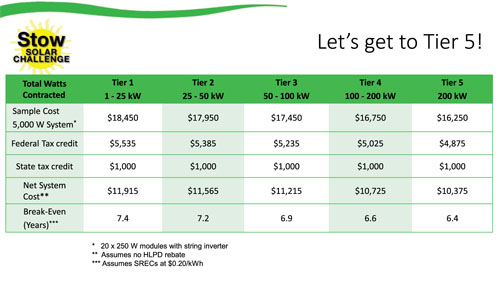
Residents packed into Town Hall Thursday night to hear from the Stow Energy Working Group and their newly chosen installer, New England Clean Energy.
The pair is embarking upon a townwide Solar Challenge to educate residents and, ultimately, increase the use of affordably priced solar systems in Stow. From now until April 2014, the Solar Challenge hopes to contract with at least 40 properties, enabling all customers to share in the lowest installation price tier.
The presentations explained how solar works, what types of properties offer ideal installation and energy producing conditions, the financing available and the refunds and payments owners might realize in return for installing a solar system.
There are systems that produce electricity to send back to the grid when excess is produced and there are systems designed to service just hot water needs. They can be large, small, on a roof, or in a field. A solar array can be mounted on a metal roof, an asphalt roof, on raised frames in a backyard or on a pole mounted structure. Roof angle and openness to available sunlight are prime considerations.
Residents were presented with the details of a No Money Down, No Interest, 100% Financing plan, that allows Stow Solar Challenge customers access to a state loan with a payback period of 10-12 years and no up-front payment. The representatives described situations in which refund checks, Solar Renewable Energy Credit checks and other incentives would provide the cash to start paying back the loan, along with saving money with reduced electric bills.
As this was primarily an educational forum, the audience had many questions, and the panel of experts provided a multitude of answers. The presentations are posted online at Sustainablestow.com and interested residents are encouraged to call the representatives of the Solar Energy Group or New England Clean Energy for more information. Here are a few responses offered from the representatives of New England Clean Energy:
• Anyone can request an assessment visit. New England Clean Energy will
evaluate a property’s ability to produce significant power, a structure’s
directional placement and other factors. Ideally, a location should be able
to produce 60% of its power from May – September.
• The solar systems, by law, immediately shut down when regular power is out
due to storms, or accidents which takes down power lines, etc. A solar
system owner, therefore, cannot make or use solar generated electricity, when
regular power service is out. It is recommended that a generator be accessed
in such instances.
• The Solar Challenge does offer smaller systems designed only to address hot
water production. While these options are available to Stow customers, hot
water installations do not count toward the goal of 40 customers, nor are they
part of the tier pricing structure. However, a reduced hot water installation
price has been negotiated for the Stow Challenge.
• Solar panels are extremely durable and can withstand a heavy snow load.
most panel repairs or replacements are covered by homeowner’s insurance,
and the experts urged homeowners to consult their own insurance carriers to
confirm specific coverage requirements.
• The panels absorb heat, creating a layer of warmth on the surface, which melts
snow that is directly in contact with the panels. Ice does not form on the
panels, and because the panels are installed 6” above the actual roof surface,
this water runoff does not cause ice dams.
By the Numbers
• The solar systems are guaranteed for 25 years, with financial pay back being
realized in 6-8 years, in most cases, up from 15 years just a short time ago.
• Solar installations are exempt from property tax increases for 20 years.
• A federal refund is available for 30% of the costs of purchase and installation.
• An automatic $1000 state tax credit is available for installing a solar system.
• Property values are believed to increase 3% after the installation of a solar system.
• Solar Renewable Energy Credits (SREC) are certificates earned by the system
owner, for every 1,000 kw/hours of energy produced. These have a current cash
value of $200, with an average system collecting 5-6 SRECs annually, or $1000-
$1200 per year.
• The SREC credit arrives as a check to the homeowner, based on meter
readings generated by the system. The check arrives every 3 months, for the
first 10 years of ownership, with the first check coming 7 months after the
system becomes operational.
• Hudson Light & Power offers rebates, but there are very specific requirements
that must be met in order to receive these payments, and only optimal
locations may qualify.
• While a solar hot water system does not qualify for Stow Solar Challenge tier
pricing, it does qualify for the immediate $30% in federal paybacks and $1000
credit from the state.
The full presentations and more information can be found by visiting www.sustainablestow.org